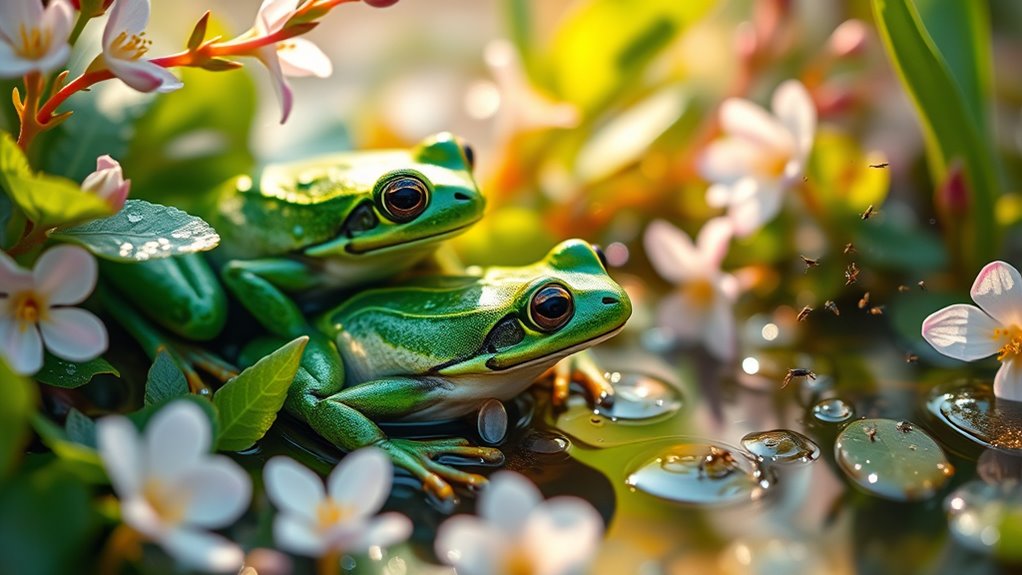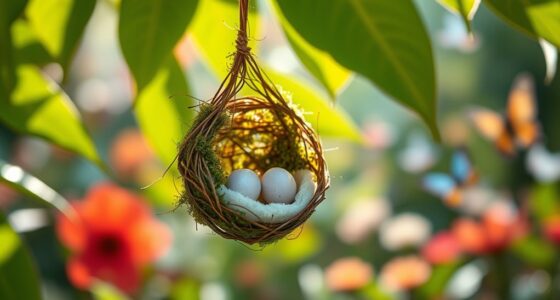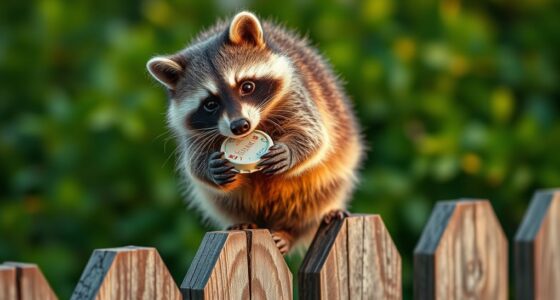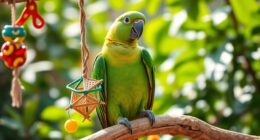Seasonal breeding’s all about timing reproduction to match environmental conditions. Many animals, like birds and mammals, take cues from changes in temperature and daylight to know when to mate. This ensures their offspring are born when food is plentiful and conditions are favorable. Hormonal changes triggered by longer days further prepare them for breeding. By adapting to these environmental signals, animals enhance their chances of survival. Stick around to uncover more about these fascinating strategies!
Key Takeaways
- Seasonal breeding ensures offspring are born when environmental conditions are most favorable for survival, often influenced by temperature and food availability.
- Photoperiod, or the length of daylight, triggers hormonal changes that prepare animals for mating during optimal seasons.
- Climate variations, such as warmer temperatures and rainfall patterns, directly impact the timing of reproduction in various species.
- Animals exhibit adaptive reproductive strategies, synchronizing their breeding with environmental cues to maximize the survival of their offspring.
- Similar to plants, animals utilize reliable environmental signals to determine the best timing for reproduction, showcasing their resilience to climate changes.
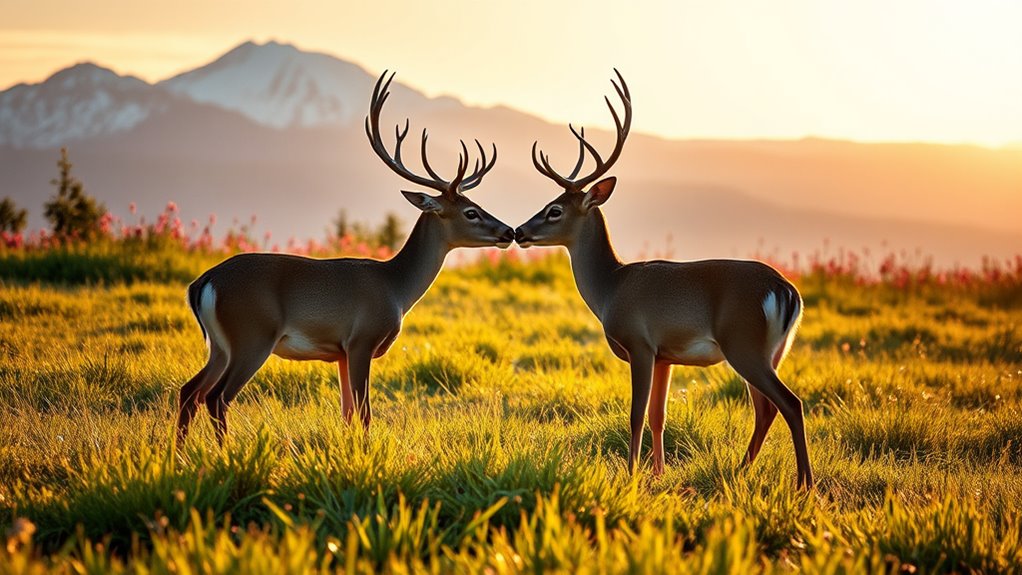
Seasonal breeding is a fascinating phenomenon that affects many animal species, including birds, mammals, and reptiles. You might wonder how these animals know when to mate and raise their young, and the answer often lies in the intricate interplay of climate influence and hormonal regulation. As the seasons change, various environmental cues signal to these animals that it’s time to reproduce, ensuring that their offspring are born at a time when conditions are most favorable for survival.
Seasonal breeding showcases how climate and hormones guide animals in timing their reproduction for optimal survival.
When you think about it, climate markedly impacts an animal’s reproductive timing. For instance, in temperate regions, the arrival of spring brings warmer temperatures and increased food availability. Animals like songbirds respond to these changes by initiating their breeding cycles. They rely on the length of daylight—known as photoperiod—as a vital trigger for hormonal changes that stimulate reproductive behaviors. You’ll notice that as the days grow longer, males often become more vocal, establishing territories and attracting mates.
Hormonal regulation plays a vital role in this seasonal breeding. When the right environmental conditions are present, animals’ bodies release hormones like testosterone and estrogen. This hormonal surge prepares them for mating and nurturing their young. You can observe this in many species; for example, female mammals often experience synchronized estrous cycles that align with the perfect time for mating. This synchronization ensures that when females are ready to mate, there are plenty of males eager to compete for their attention.
It’s not just temperature and light that influence breeding; rainfall patterns and food supply can also trigger seasonal breeding behaviors. In tropical regions, for instance, some species breed following the rainy season when resources are abundant. You might be surprised to learn that these animals can adapt their reproductive strategies based on changing climate conditions, demonstrating remarkable flexibility and resilience. This adaptability can be likened to plants using self-watering planters to ensure optimal growth conditions for their survival.
Frequently Asked Questions
How Does Climate Change Affect Seasonal Breeding Patterns?
Climate change disrupts seasonal breeding patterns by altering climate variability, which affects food availability and habitat conditions. As temperatures rise, you may notice shifts in migration timing for many species. Animals might arrive at breeding grounds earlier or later than usual, leading to mismatches with resource peaks. This can impact survival rates of offspring and overall population dynamics, forcing animals to adapt quickly to these unpredictable changes in their environments.
Can Artificial Lighting Influence Seasonal Breeding in Animals?
Yes, artificial lighting can considerably influence seasonal breeding in animals. Studies show that over 30% of wild animals are affected by light pollution, altering their natural behaviors. Through photoperiod manipulation, you can simulate longer days, which tricks animals into thinking it’s time to breed. This can lead to mismatched timing in reproduction cycles, potentially disrupting ecosystems. So, while artificial light can aid breeding in controlled environments, it can also have unintended consequences in the wild.
What Are the Consequences of Disrupted Seasonal Breeding Cycles?
Disrupted seasonal breeding cycles can lead to genetic disruptions and decreased reproductive success. You might notice that animals struggle to find mates or raise offspring in altered environments. Habitat fragmentation exacerbates these issues, isolating populations and reducing genetic diversity. Consequently, this can result in inbreeding and lower resilience to environmental changes. If you observe these patterns, it’s vital to take into account how human activities impact both breeding cycles and overall ecosystem health.
How Do Different Species Synchronize Their Breeding Seasons?
Different species synchronize their breeding seasons by responding to photoperiod cues, like changes in daylight length. You’ll notice that many animals, such as birds and mammals, undergo hormonal regulation in response to these cues, triggering reproductive behaviors. As daylight increases, hormones such as testosterone and estrogen rise, prompting mating activities. This synchronization helps guarantee that offspring are born during ideal environmental conditions, maximizing their chances for survival and growth.
Are There Any Human Activities That Impact Animal Reproduction Timing?
Yes, human activities substantially impact animal reproduction timing. Urban development disrupts habitats, forcing animals to adapt their breeding cycles. Pollution, like chemicals and noise, can alter hormonal levels and stress animals, leading to delayed reproduction. You might notice that species in heavily developed areas struggle to breed as effectively as those in natural environments. By understanding these influences, we can make better choices to protect wildlife and their reproductive health.
Conclusion
As the sun dips below the horizon, painting the sky in hues of orange and purple, nature awakens in a symphony of life. You can almost hear the rustle of leaves and the soft calls of creatures as they prepare for their seasonal dance of reproduction. Timing is everything; it’s a delicate balance between instinct and environment. Embrace the rhythm of nature, and you’ll witness the magic of life unfolding, a reminder that we’re all intertwined in this beautiful cycle.
